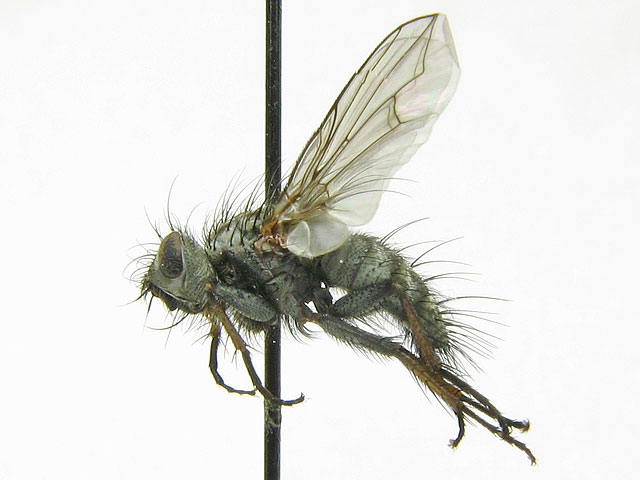Diptera.info :: Identification queries :: Diptera (adults)
|
Campylocheta latigena?
|
|
| ChrisR |
Posted on 19-12-2009 23:35
|
|
Super Administrator Location: Reading, England Posts: 7706 Joined: 12.07.04 |
Another Campylocheta - possibly latigena? Estonia - 14.5.2005
ChrisR attached the following image:  [44.14Kb] Manager of the UK Species Inventory in the Angela Marmont Centre for UK Biodiversity at the Natural History Museum, London. |
| ChrisR |
Posted on 19-12-2009 23:35
|
|
Super Administrator Location: Reading, England Posts: 7706 Joined: 12.07.04 |
another view...
ChrisR attached the following image:  [45.53Kb] Manager of the UK Species Inventory in the Angela Marmont Centre for UK Biodiversity at the Natural History Museum, London. |
| Zeegers |
Posted on 20-12-2009 13:54
|
|
Member Location: Soest, NL Posts: 19243 Joined: 21.07.04 |
It is a female.... Theo |
|
|
|
| ChrisR |
Posted on 20-12-2009 14:06
|
|
Super Administrator Location: Reading, England Posts: 7706 Joined: 12.07.04 |
Ahh, does this mean that females cannot reliably be identified ... or just that it is a female C.latigena ? 
Manager of the UK Species Inventory in the Angela Marmont Centre for UK Biodiversity at the Natural History Museum, London. |
| neprisikiski |
Posted on 20-12-2009 16:23
|
|
Member Location: Lithuania Posts: 876 Joined: 23.02.09 |
Chris, latigena is a rather southern species, you shouldnt exclude mariae that has strongly modified female postabdomen.. Erikas |
|
|
|
| ChrisR |
Posted on 20-12-2009 16:42
|
|
Super Administrator Location: Reading, England Posts: 7706 Joined: 12.07.04 |
Thanks - is there a better key for Campylocheta than the one in Tschorsnig & Herting (1994)? I noticed it doesn't have C.mariae 
Manager of the UK Species Inventory in the Angela Marmont Centre for UK Biodiversity at the Natural History Museum, London. |
| Jaakko |
Posted on 20-12-2009 20:29
|
|
Member Location: Joensuu, Finland Posts: 479 Joined: 04.08.08 |
If you check Erikas recent post, there is an easy habitus difference, incl. the lack of strong costal bristle. Same as for the male; to my opinion both C. praecox. C. mariae and C. ziegleri(!!) were described only recently (2001), so that's why they're not in T&H. Shortly: genal dilation black haired, strong costal bristle, wings without infuscated spots, tibia almost black, parafacial narrower than third antennal segment. --> mariae Otherwise as above, but parafacial wider, mid- and hind tibiae yellow and male terminalia different --> ziegleri. Always nice to dig through some strange specimen sets, never knows what to expect..  |
|
|
|
| ChrisR |
Posted on 20-12-2009 21:50
|
|
Super Administrator Location: Reading, England Posts: 7706 Joined: 12.07.04 |
Thanks - I have had another look and I agree with C.praecox now - it has many more rows of black bristles behind the head than C.latigena should have 
Manager of the UK Species Inventory in the Angela Marmont Centre for UK Biodiversity at the Natural History Museum, London. |
| neprisikiski |
Posted on 20-12-2009 23:34
|
|
Member Location: Lithuania Posts: 876 Joined: 23.02.09 |
I just wish to add to Jaakko`s comment that tibiae are dark in mariae males only, while in females all tibiae are usually reddish!
Edited by neprisikiski on 20-12-2009 23:36 Erikas |
|
|
|
| ChrisR |
Posted on 20-12-2009 23:52
|
|
Super Administrator Location: Reading, England Posts: 7706 Joined: 12.07.04 |
Thanks for that - I have added all comments to my copy of T&H. Has anyone tried to modify T&H to insert the new species into the couplets? 
Manager of the UK Species Inventory in the Angela Marmont Centre for UK Biodiversity at the Natural History Museum, London. |
| Jaakko |
Posted on 21-12-2009 08:33
|
|
Member Location: Joensuu, Finland Posts: 479 Joined: 04.08.08 |
neprisikiski wrote: I just wish to add to Jaakko`s comment that tibiae are dark in mariae males only, while in females all tibiae are usually reddish! Oh - yes, of course.. I was in my head answering the earlier thread which had the male..  |
|
|
|
| Jump to Forum: |













